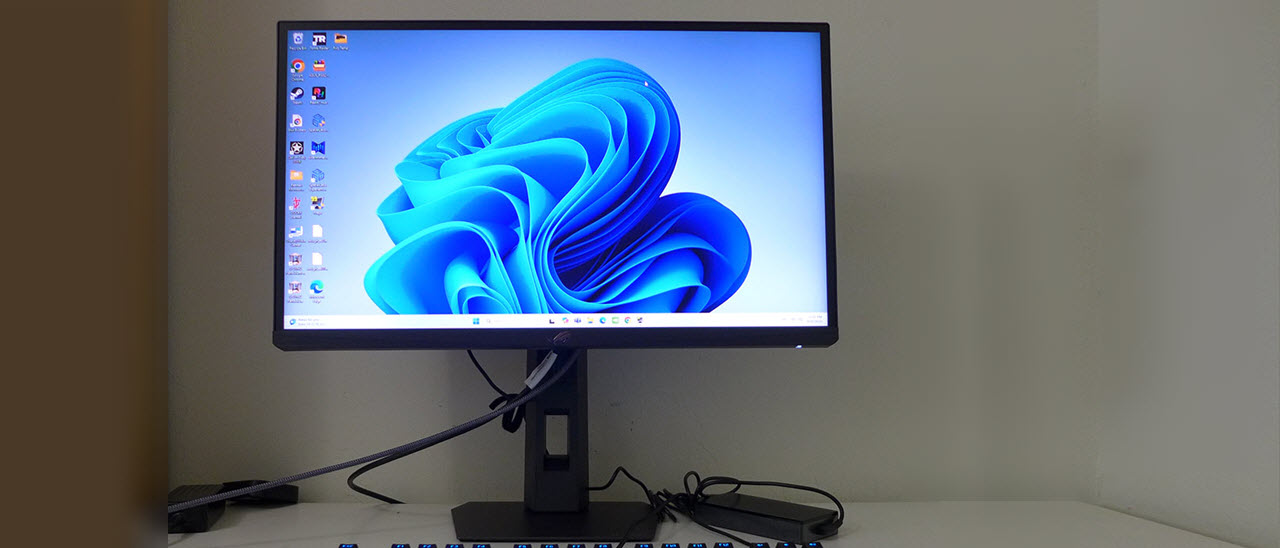Why you can trust Tom's Hardware
To read about our monitor tests in-depth, please check out Display Testing Explained: How We Test PC Monitors. We cover brightness and contrast testing on page two.
Uncalibrated – Maximum Backlight Level
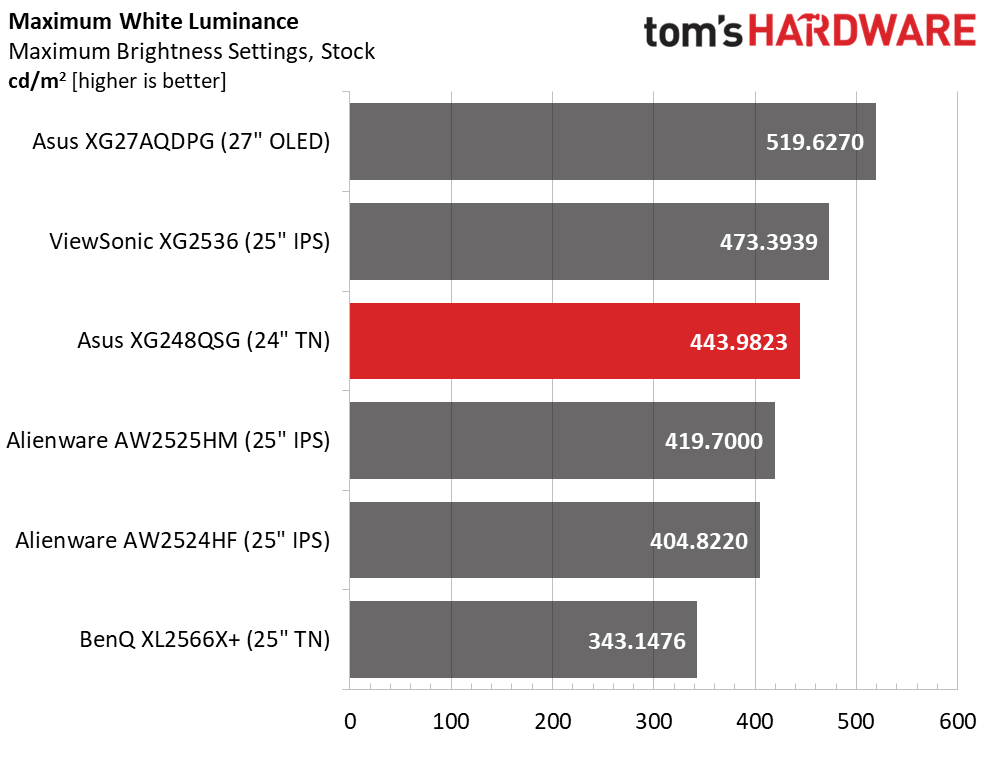
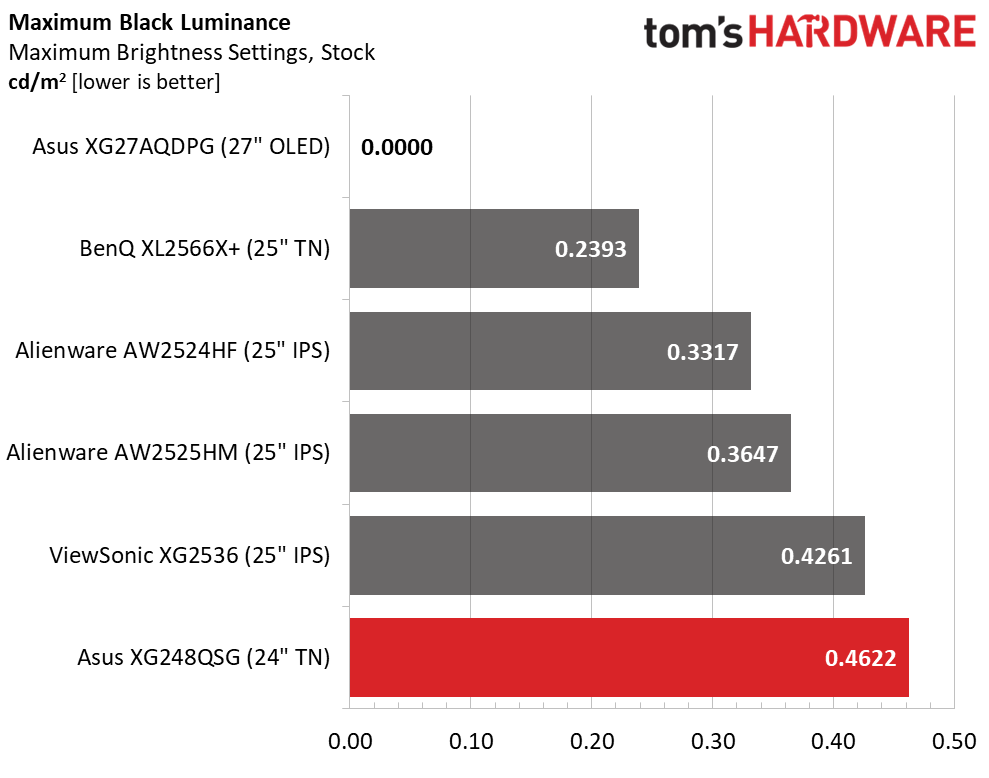
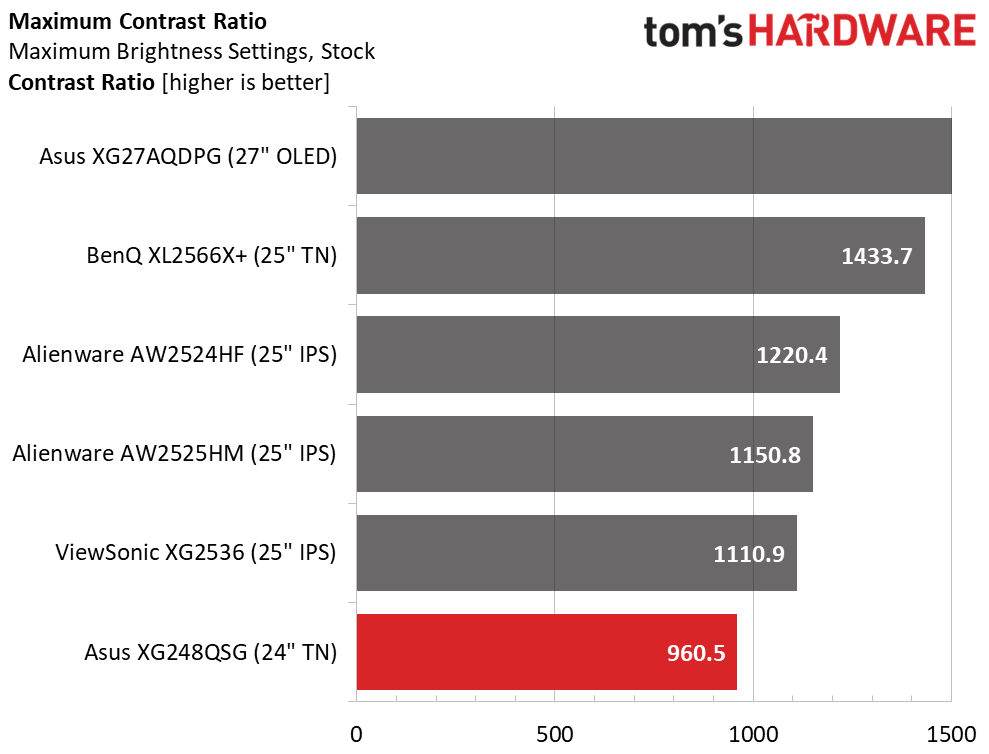
The XG248QSG has plenty of light output available, which is a good thing because it provides headroom for the ELMB feature and enhances the impact of HDR content. I measured almost 444 nits in SDR mode. You won’t get more output with dynamic dimming turned on, but that option deepens black levels to where they cannot be measured. To get a real-world result, I left it off and recorded a static contrast ratio of 960.5:1
After Calibration to 200 nits
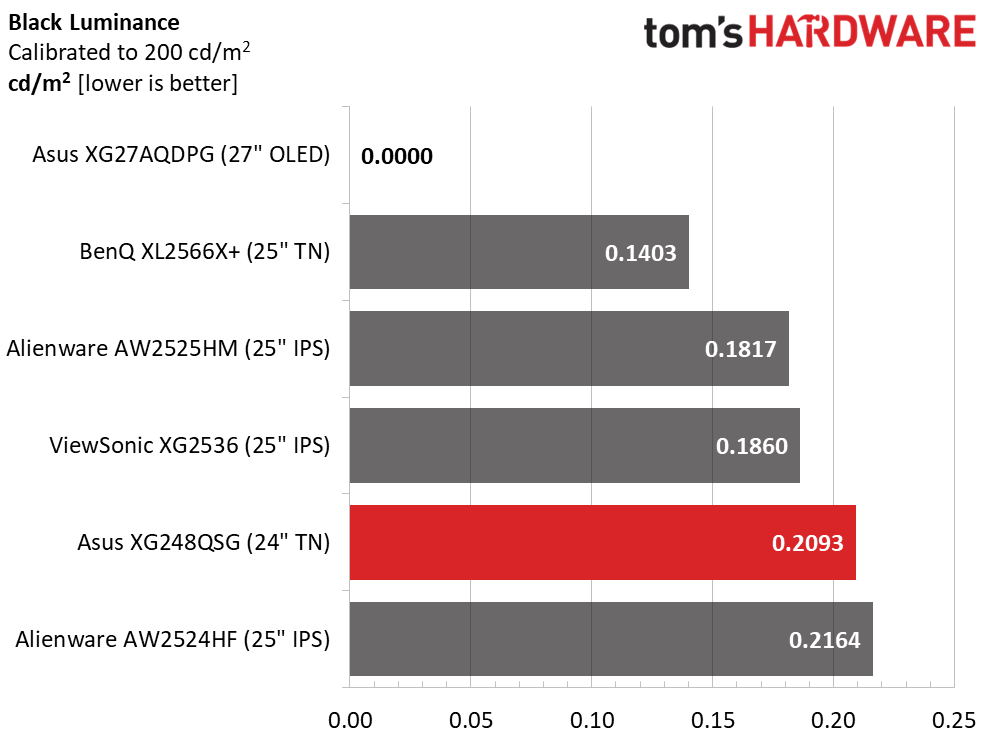
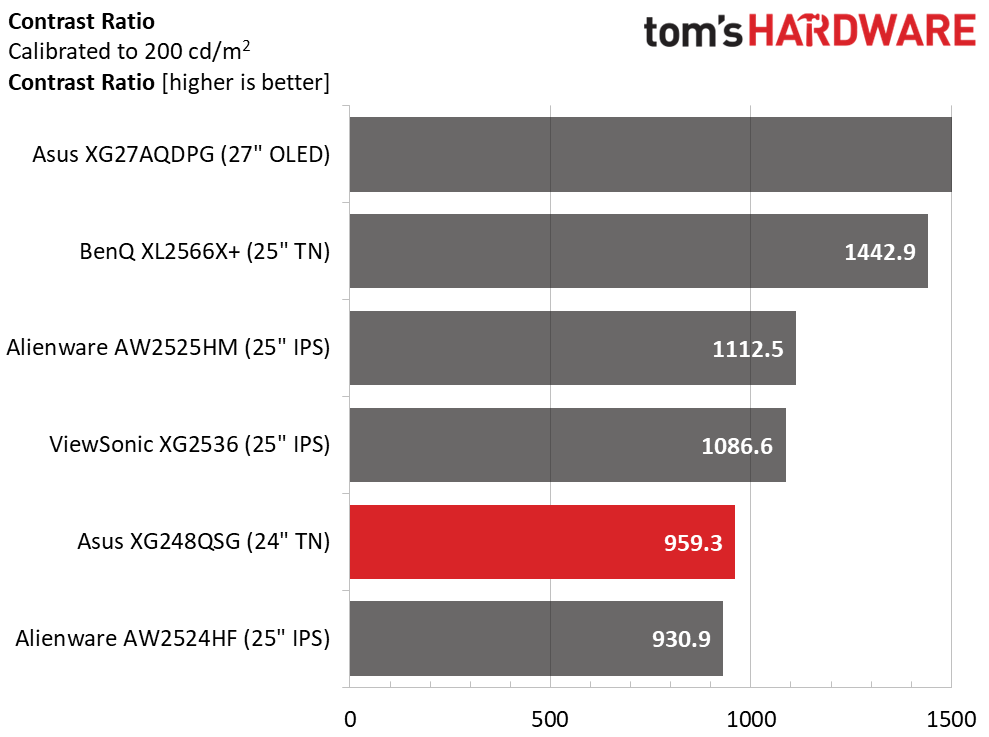
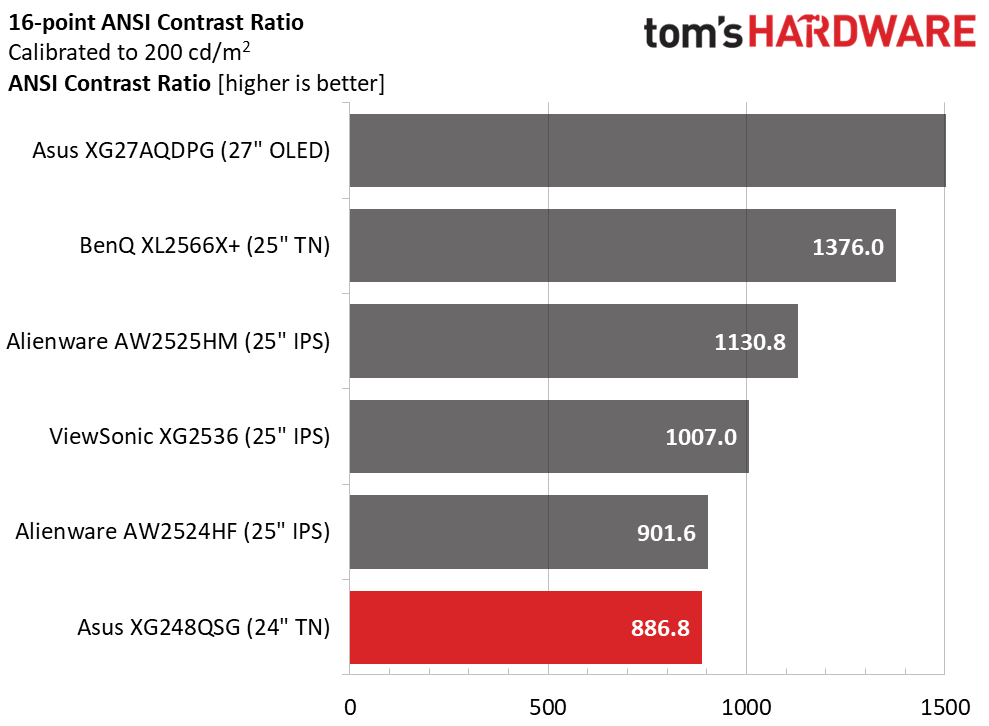
Calibrating the XG248QSG was interesting because I had to increase the contrast slider to solve color clipping issues. That meant there was no change in the static ratio, it’s still around 960:1. You can get more contrast with dynamic dimming, but when measuring a black field pattern, the backlight is off, so I can’t get a value. The ANSI test also returned an average result of 886.8:1.
Comparing an OLED here is clearly unfair, but I included it because it’s close in price and speed to the XG248QSG and the other LCD screens.
Test Takeaway: If you want the highest possible frame rates, the XG248QSG provides that along with high brightness and excellent (for a TN LCD) contrast. It’s just under 1,000:1 natively, so it compares well with typical TN and IPS screens. But if image depth is more important to you than sheer speed, an OLED or VA panel is a better option.
MORE: Best Gaming Monitors
MORE: How We Test PC Monitors
Get Tom's Hardware's best news and in-depth reviews, straight to your inbox.
MORE: How to Buy a PC Monitor
Current page: Brightness and Contrast
Prev Page Response, Input Lag, Viewing Angles and Uniformity Next Page Grayscale, Gamma and Color
Christian Eberle is a Contributing Editor for Tom's Hardware US. He's a veteran reviewer of A/V equipment, specializing in monitors. Christian began his obsession with tech when he built his first PC in 1991, a 286 running DOS 3.0 at a blazing 12MHz. In 2006, he undertook training from the Imaging Science Foundation in video calibration and testing and thus started a passion for precise imaging that persists to this day. He is also a professional musician with a degree from the New England Conservatory as a classical bassoonist which he used to good effect as a performer with the West Point Army Band from 1987 to 2013. He enjoys watching movies and listening to high-end audio in his custom-built home theater and can be seen riding trails near his home on a race-ready ICE VTX recumbent trike. Christian enjoys the endless summer in Florida where he lives with his wife and Chihuahua and plays with orchestras around the state.
-
Shiznizzle $1000 for a 1080p rectangle thing.Reply
Is it possible to tell the difference between 120 hz and 340 hz?
Possibly, but i doubt it.
How about from 340 to 610?
My answer is no.
If you say yes, then do a blind test and tell us which is which once there are enough 600 hz monitors on the market so you cant learn their color profiles and base your decision on that. Better yet. Do a black and white 600 hz test. Refresh rate is refresh rate so color should not matter. You clain to see the difference so tell us which one.
What do you mean you cant see the difference between 610 and 472? Are you blind?
We are now getting into the absurd levels of tech that not even humans can see the difference of. -
timsSOFTWARE Reply
You can certainly tell the difference between even 120 and 240 - ex. just move the mouse or a window around on the desktop. And because there is still motion blur even at 240, even reducing that by a further 2/3s with 700hz - there would still probably be room to reduce it further; maybe going to 2-3Khz before you'd be hard pressed to tell it was there.Shiznizzle said:$1000 for a 1080p rectangle thing.
Is it possible to tell the difference between 120 hz and 340 hz?
Possibly, but i doubt it.
How about from 340 to 610?
My answer is no.
If you say yes, then do a blind test and tell us which is which once there are enough 600 hz monitors on the market so you cant learn their color profiles and base your decision on that. Better yet. Do a black and white 600 hz test. Refresh rate is refresh rate so color should not matter. You clain to see the difference so tell us which one.
What do you mean you cant see the difference between 610 and 472? Are you blind?
We are now getting into the absurd levels of tech that not even humans can see the difference of.
But for professional gamers that buy these monitors, I think the bigger gain is actually in input lag from running at higher FPS, and being able to run the game effectively uncapped FPS wise without introducing screen tearing. -
Toomanyuserstaken So when you tested the input lag for this monitor, did you run the highest overdrive settings? Wouldn’t this improve the input lag scores even further? With asus claims of .8ms input latency you would assume this would be the fastest monitor ever created, but it isn’t even top 5!Reply -
Toomanyuserstaken Reply
Also, do you plan to test the asus pg27aqwp-w?Toomanyuserstaken said:So when you tested the input lag for this monitor, did you run the highest overdrive settings? Wouldn’t this improve the input lag scores even further? With asus claims of .8ms input latency you would assume this would be the fastest monitor ever created, but it isn’t even top 5!
I am almost positive this will be the fastest monitor when speaking about input lag. Especially with no DSC
